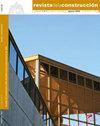集料粒度和聚乙烯板材养护对轻质膨胀粘土集料混凝土力学性能和微观结构性能的影响
IF 1.4
4区 工程技术
引用次数: 0
摘要
本研究评估了轻质膨胀粘土骨料(LECA)粒径和聚乙烯混凝土养护膜(PCCF)养护对两种不同Dmax(16或22.4 mm)下结构轻骨料混凝土(LWAC)的微观结构、界面过渡区(ITZ)和抗压强度的影响。为此,通过单位重量、1、7和28天的抗压强度测试和SEM-EDX观察,对2个系列的正常重量骨料混凝土(NWAC)和6个系列的LWAC进行了评估,其中LWAC含有40%体积未预湿的LECA,粒径为(0- 3,3 -8或8-16毫米)。通过PCCF养护防止新拌混凝土的水分流失,对1天和28天的抗压强度分别提高了14%和9%。随着LECA晶粒尺寸的减小,LECA的壳厚显著增加。因此,LECA和LWAC的抗压强度随LECA晶粒尺寸的减小而增大。含0 ~ 3mm LECA的LWAC的抗压强度比NWAC的抗压重量比提高了21%,这得益于细LECA颗粒的火山灰反应性。本文章由计算机程序翻译,如有差异,请以英文原文为准。
Effect of aggregate size and polyethylene sheet curing on me-chanical and microstructural properties of lightweight expanded clay aggregate concrete
This study assessed the effect of lightweight expanded clay aggregate (LECA) grain size and curing with polyethylene concrete curing film (PCCF) on microstructure, interfacial transition zone (ITZ), and compressive strength of structural lightweight aggregate concrete (LWAC) produced with two different Dmax (16 or 22.4 mm). To this end, 2 series of normal weight aggregate concretes (NWAC) and 6 series of LWAC incorporating 40% by vol. unprewetted LECA having (0-3, 3-8, or 8-16 mm) grain sizes were evaluated by using unit weight, compressive strength tests at 1, 7, and 28 days and SEM-EDX observations. Preventing the moisture loss from fresh concrete through PCCF curing had positive effects on compressive strength up to 14 and 9% for 1 and 28 days respectively. Shell thickness of LECA considerably increased with the decrease in LECA grain size. Thus, the compressive strength of LECA and LWAC increased by the decrease in LECA grain size. LWAC containing 0-3 mm LECA, achieved up to 21% higher compressive strength to weight ratio compared with the NWAC with the aid of the pozzolanic reactivity of fine LECA particles.
求助全文
通过发布文献求助,成功后即可免费获取论文全文。
去求助
来源期刊

Revista de la Construccion
工程技术-工程:土木
CiteScore
2.30
自引率
21.40%
发文量
0
期刊介绍:
The Journal of Construction is aimed at professionals, constructors, academics, researchers, companies, architects, engineers, and anyone who wishes to expand and update their knowledge about construction. We therefore invite all researchers, academics, and professionals to send their contributions for assessment and possible publication in this journal. The publications are free of publication charges.
OBJECTIVES
The objectives of the Journal of Construction are:
1. To disseminate new knowledge in all areas related to construction (Building, Civil Works, Materials, Business, Education, etc.).
2. To provide professionals in the area with material for discussion to refresh and update their knowledge.
3. To disseminate new applied technologies in construction nationally and internationally.
4. To provide national and foreign academics with an internationally endorsed medium in which to share their knowledge and debate the topics raised.
 求助内容:
求助内容: 应助结果提醒方式:
应助结果提醒方式:


